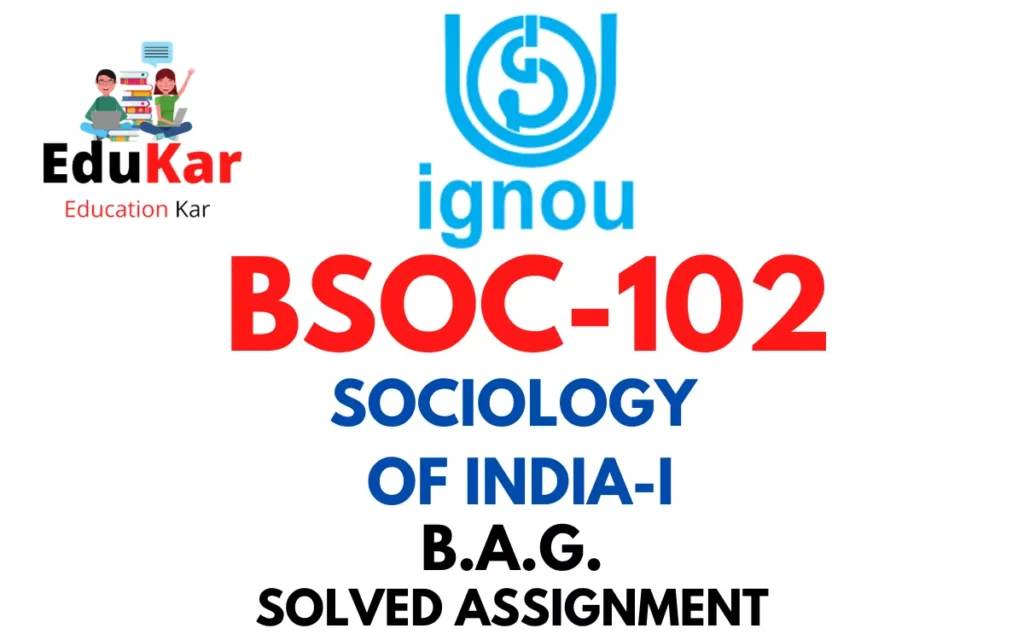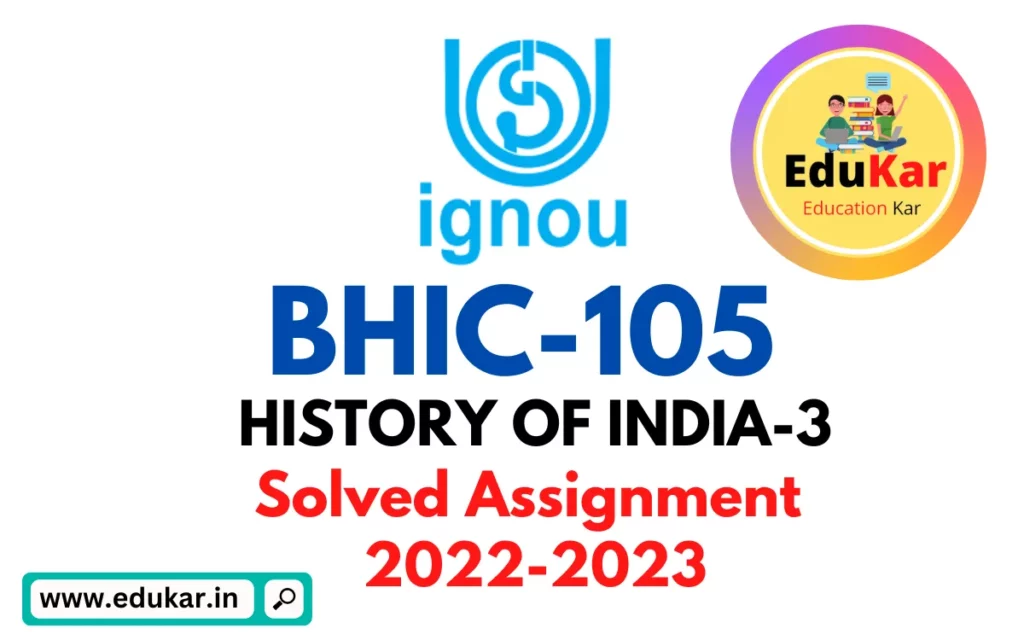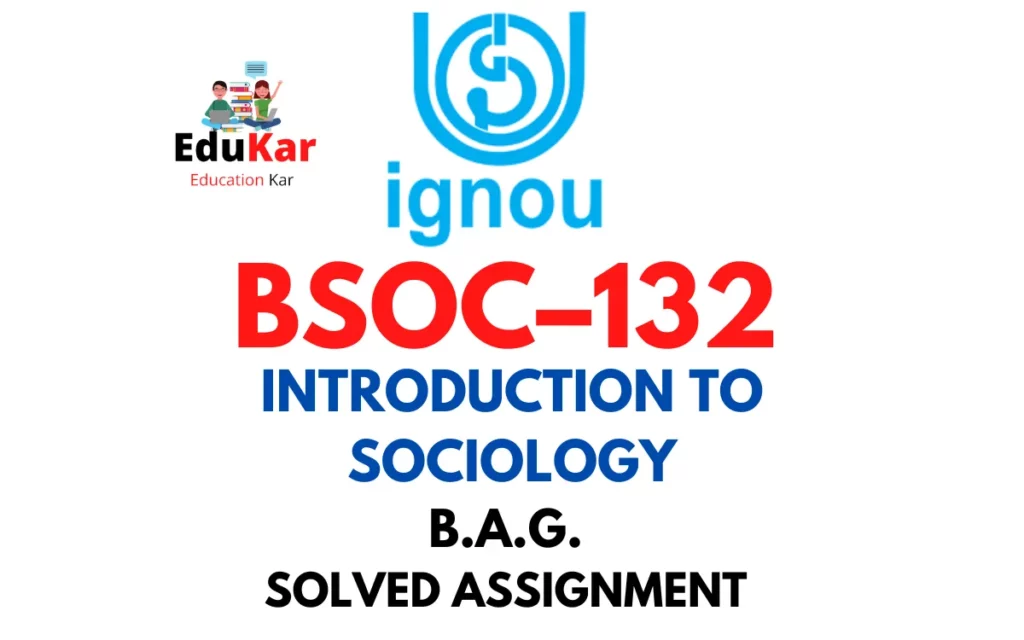Contents
- 1 Assignment – I
- 2 Answer the following in about 500 words each. 20X2=40
- 3 a. Discuss the concept of tribes and peasantry. Define the characteristics of a tribeand Indian village.
- 4 b. Write a note on the history of tribal administration in India.
- 5 Assignment – II
- 6 Answer the following in about 250 words each. (Write Short Notes) 10X2=20
- 7 a. Deliberate on the approaches to the study of peasants.
- 8 b. Write a note on the problems faced by tribes.
- 9 Answer the following questions in about 75 words each. 2X5=10
- 10 a. Ethno-political movements
- 11 b. Singur Project in West-Bengal
- 12 c. Polavaram Project
- 13 d. Planning Commission and NITI Aayog
- 14 Assignment – III
- 15 a. What is Fieldwork? Explain the methods, tools and techniques you would use tocollect data in a tribal village. Describe what would be your universe and unit ofstudy.
- 16 b. Discuss qualitative analysis of data and report writing.
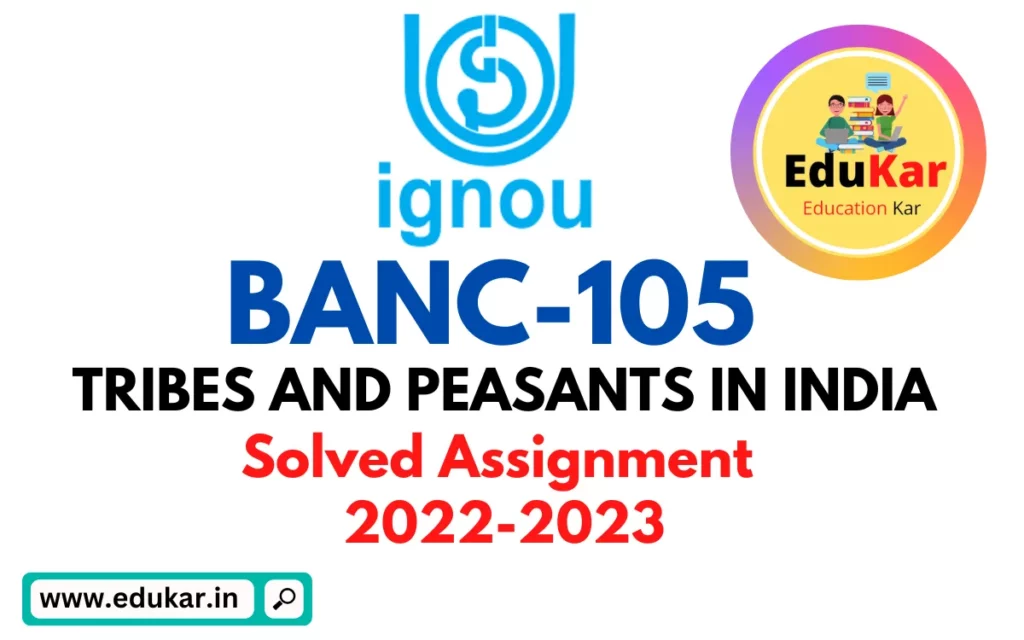
| Title | BANC 105: IGNOU BAG Solved Assignment 2022-2023 |
| University | IGNOU |
| Degree | Bachelor Degree Programme |
| Course Code | BANC 105 |
| Course Name | TRIBES AND PEASANTS IN INDIA |
| Programme Name | Bachelor of Arts (General) |
| Programme Code | BAG |
| Total Marks | 100 |
| Year | 2022-2023 |
| Language | English |
| Assignment Code | BANC 105/ASST/TMA/July 2022 and January 2023 |
| Last Date for Submission of Assignment: | For June Examination: 31st April For December Examination: 30th September |
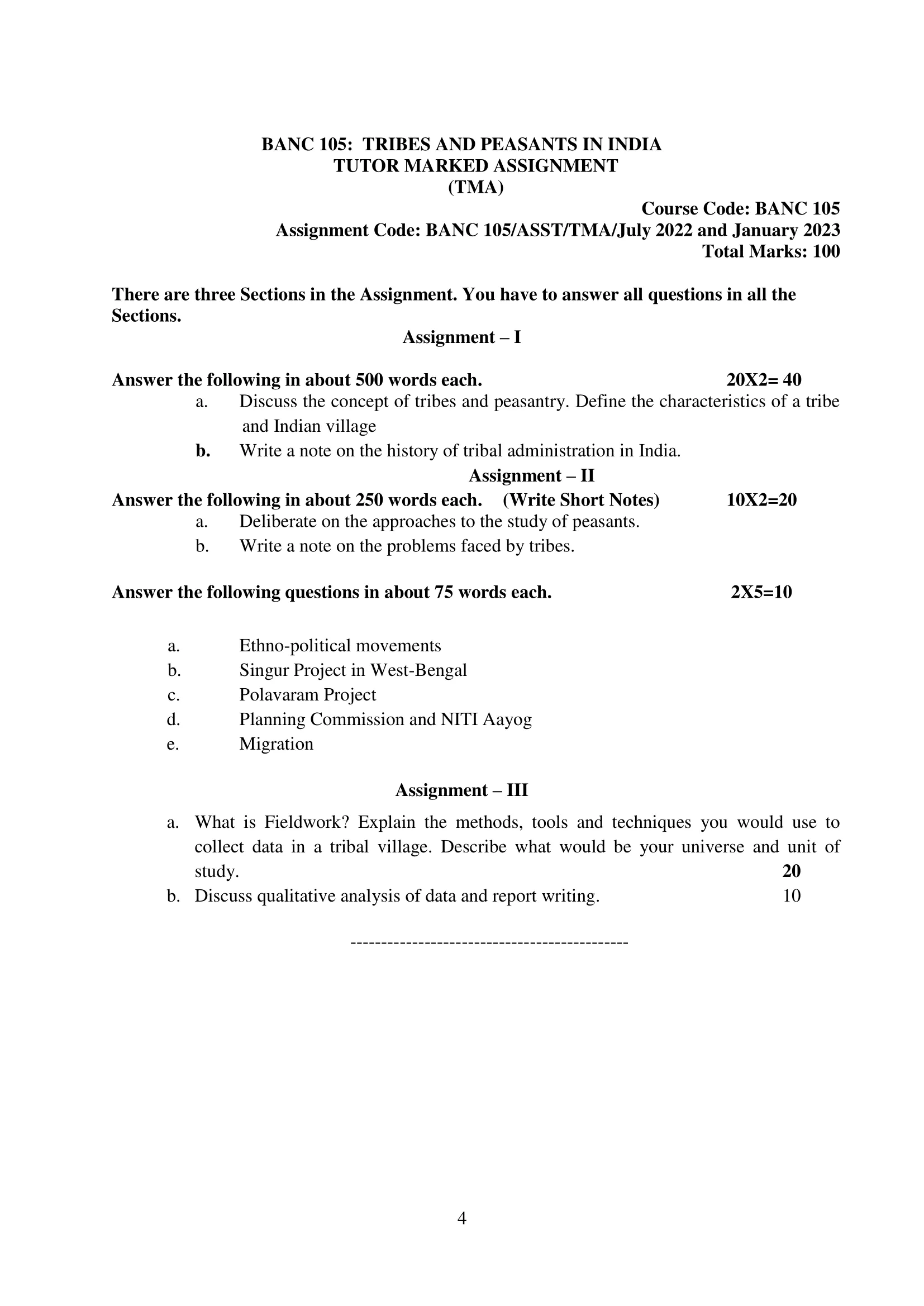
Assignment – I
Answer the following in about 500 words each. 20X2=40
a. Discuss the concept of tribes and peasantry. Define the characteristics of a tribe
and Indian village.
Ans: Tribe is a social group of people with a common culture, language, customs, and ancestry. They live together in a particular geographical region and are known for their shared traditions, values, and rituals. Tribe is an organized social structure that is often self-sufficient and has its own political and economic systems.
Peasantry, on the other hand, refers to a social class of people who live in rural areas and depend on agriculture for their livelihood. Peasants are typically poor, with limited access to resources and political power. They are often exploited by landlords and other powerful members of society.
The characteristics of a tribe include a strong sense of community, shared cultural practices and beliefs, and a belief in a common ancestry. Tribe members have a shared history, language, and customs. They often have a hierarchical social structure, with leaders who hold political and economic power. The social structure of a tribe is often organized around clans or extended families, with a shared economic system that involves the collective use of resources.
An Indian village, on the other hand, is a community of people who live together in a rural area. Indian villages are known for their strong sense of community, traditional cultural practices, and close-knit relationships. Indian villages are often self-sufficient, with residents relying on agriculture, small-scale commerce, and other local activities for their livelihoods. In many Indian villages, the social structure is based on extended families, castes, and religious affiliations.
Both tribes and Indian villages have a strong sense of community and cultural identity, but there are also some key differences between the two. While tribes are typically smaller and more isolated, Indian villages are often part of larger regional systems and have more connections to the outside world. Additionally, Indian villages are more likely to have a hierarchical social structure, with defined leaders and a more complex economic system.
b. Write a note on the history of tribal administration in India.
Ans: The history of tribal administration in India dates back to the colonial period when British administrators introduced various policies aimed at controlling and regulating the tribes. In the early 19th century, the British implemented the “settlement policy” which aimed to bring tribal areas under their control and to pacify and assimilate the tribes into mainstream society. The policy involved the survey and settlement of tribal lands and the imposition of new land revenue systems.
After India gained independence in 1947, the tribal administration was governed by the provisions of the Constitution of India. The Indian government recognized the unique cultural, social, and economic status of tribes and made provisions for their protection and welfare. In 1952, the government established the Ministry of Tribal Affairs to oversee the development and welfare of tribes in India.
In the late 1950s and early 1960s, the Indian government implemented the “tribal sub-plan” which aimed to provide tribes with specialized development programs to improve their economic and social conditions. The tribal sub-plan provided funding for education, health, and other social services for tribes.
In recent years, the Indian government has made significant efforts to promote the development of tribal communities and to protect their rights and interests. The government has implemented various schemes and programs aimed at improving the economic and social conditions of tribes, including the Pradhan Mantri Adivasi Awas Yojana, which provides housing for tribal families, and the Scheduled Tribes and Other Traditional Forest Dwellers (Recognition of Forest Rights) Act, which recognizes the rights of tribal communities to access and manage forest resources.
Assignment – II
Answer the following in about 250 words each. (Write Short Notes) 10X2=20
a. Deliberate on the approaches to the study of peasants.
Ans: The study of peasants can be approached from various perspectives and disciplines, including history, sociology, anthropology, economics, and political science.
Historical approach views peasants as a social group that has its roots in the feudal system and has evolved over time in response to political, economic, and technological changes. This approach focuses on the social, economic, and cultural structures of peasant societies and the ways in which they have changed over time.
Sociological approach examines the social organization, culture, and norms of peasant communities. This approach looks at the relationships between different classes within peasant societies, such as landlords and tenant farmers, as well as the relationships between peasants and the state.
Anthropological approach focuses on the cultural practices and beliefs of peasant communities, as well as their relationships with the natural environment and the use of natural resources. This approach views peasants as culturally distinct groups with their own unique beliefs and practices.
Economic approach considers the economic activities and strategies of peasants, such as agriculture, trade, and migration. This approach examines the ways in which peasant economies have evolved in response to changes in the global economy, such as the introduction of new technologies and the expansion of markets.
Political science approach focuses on the relationship between peasants and the state, including the ways in which state policies and institutions have shaped peasant societies and the ways in which peasants have responded to these policies. This approach considers the role of peasants in political movements and rebellions, as well as their representation in political institutions.
b. Write a note on the problems faced by tribes.
Ans: Tribes, also known as indigenous peoples, are among the most marginalized and disadvantaged groups in many countries. They face a wide range of problems, some of which are outlined below:
- Land rights: Tribes often face difficulties in securing and maintaining their ancestral lands, which are often coveted by outside interests such as corporations, governments, and settlers. This can lead to displacement, loss of livelihoods, and cultural destruction.
- Economic marginalization: Many tribes are located in remote areas with limited economic opportunities, and they often face discrimination and exclusion from mainstream economic activities. This can lead to poverty, unemployment, and underdevelopment.
- Political marginalization: Tribes are often excluded from political processes and decision-making, and their voices are not adequately represented in government and other institutions. This can lead to ineffective policies and lack of representation for tribal interests.
- Health problems: Tribes often face significant health disparities, including higher rates of infectious diseases, malnutrition, and maternal and child mortality. They may also have limited access to healthcare services, due to remoteness and lack of resources.
- Education: Education is often not accessible or relevant for tribal children, who may not be able to attend school due to poverty, geographic barriers, or discrimination. This can limit their opportunities for future employment and advancement.
- Culture and identity: Tribes often face threats to their cultural heritage and traditions, including language loss and erosion of traditional practices. They may also face discrimination and prejudice from non-tribal communities, which can undermine their sense of identity and belonging.
Overall, tribes face many challenges that are rooted in historical and ongoing injustices, such as colonization, exploitation, and discrimination. Addressing these problems requires a commitment to tribal rights, self-determination, and cultural preservation.
Answer the following questions in about 75 words each. 2X5=10
a. Ethno-political movements
Ans: Ethno-political movements are political movements that are organized around ethnic or cultural identities. These movements aim to promote the interests and rights of a particular ethnic group, often with the goal of securing greater autonomy, representation, or independence. Ethno-political movements can take many forms, including peaceful political activism, protests, and armed conflict. They are often fueled by historical injustices, discrimination, and marginalization of the ethnic group in question. Examples of ethno-political movements include the Kurdish independence movement, the Catalonian independence movement, and the Black Lives Matter movement.
b. Singur Project in West-Bengal
Ans: The Singur Project was a controversial industrial project in West Bengal, India. It involved the acquisition of fertile agricultural land by the West Bengal government for the construction of a factory by Tata Motors. The project faced opposition from local farmers who were protesting against the acquisition of their land. The project also faced criticism from political parties and social activists who raised concerns about the displacement of local communities and the loss of fertile agricultural land. The project was eventually cancelled due to public pressure and political opposition, leading to a significant loss of investment and employment opportunities in the region. The Singur Project remains a significant event in the history of land acquisition and industrial development in India.
c. Polavaram Project
Ans: The Polavaram Project is a major multi-purpose irrigation project located in the Indian state of Andhra Pradesh. It is being built across the Godavari River with the aim of providing irrigation to over 7 lakh hectares of land, as well as providing drinking water to the surrounding areas. The project also aims to generate hydroelectric power, making it one of the largest projects of its kind in India. The project has faced criticism from environmental groups, who have raised concerns about the displacement of local communities and the impact of the project on the local ecosystem. Despite this, the project has been given national project status by the Indian government, signifying its importance for the development of the region. The project is currently underway and is expected to be completed in the coming years.
d. Planning Commission and NITI Aayog
Ans: The Planning Commission was a government body in India established in 1950 with the objective of promoting balanced regional development and achieving national economic goals through a central planning process. It was responsible for the preparation of the Five-Year Plans, which served as the blueprint for the country’s economic development. The Planning Commission played a crucial role in shaping India’s economic policies and was considered the apex body for making recommendations on economic and social policies.
In 2015, the Planning Commission was replaced by the National Institution for Transforming India (NITI) Aayog. NITI Aayog is a think-tank established by the Government of India with the aim of providing a strategic and vision-oriented direction to the country’s economic policy-making. It acts as a link between the central and state governments, providing a platform for cooperative federalism. NITI Aayog has a broader mandate than the Planning Commission and its role includes the preparation of the national development agenda, the design of innovative policies, and the fostering of cooperative federalism.
Assignment – III
a. What is Fieldwork? Explain the methods, tools and techniques you would use to
collect data in a tribal village. Describe what would be your universe and unit of
study.
Ans: Fieldwork refers to the process of collecting data and conducting research in a real-world setting, typically in a location outside of a laboratory or office environment. Fieldwork is an important aspect of social science research, particularly in the study of communities and cultures.
To collect data in a tribal village, there are several methods, tools, and techniques that can be used, including:
- Interviews: One-on-one interviews with members of the tribe can provide valuable insights into their attitudes, beliefs, and behaviors. These can be structured interviews, where questions are asked in a standardized manner, or unstructured interviews, where the researcher engages in a more informal conversation with the participant.
- Surveys: Surveys can be used to gather data on a large scale and can be administered either in person or online. Surveys can include both open-ended and closed-ended questions and can provide quantitative data on a variety of topics, such as demographics, opinions, and behaviors.
- Observations: Observing the behavior of members of the tribe can provide valuable insights into their daily lives and cultural practices. Observations can be structured, where the researcher observes specific behaviors or events, or unstructured, where the researcher simply observes and takes notes on what they see.
- Focus groups: Focus groups involve a small group of individuals who are brought together to discuss a particular topic or issue. These can provide valuable insights into the attitudes and beliefs of the tribe as a whole.
The universe of study would be the entire tribe and the unit of study would be individual members of the tribe. It is important to keep in mind ethical considerations when conducting fieldwork in a tribal village, such as obtaining informed consent from participants, protecting their privacy and confidentiality, and ensuring their well-being.
b. Discuss qualitative analysis of data and report writing.
Ans: Qualitative analysis of data refers to the process of interpreting, categorizing, and making sense of the data collected through qualitative research methods. Qualitative data is often in the form of unstructured or semi-structured data, such as interviews, observations, and focus groups, and it is analyzed in a way that seeks to uncover patterns, themes, and relationships within the data.
The following are some of the common steps involved in qualitative data analysis:
- Data organization: Organizing the data collected in a systematic and manageable way, such as by creating a coding scheme or using qualitative data analysis software.
- Coding: Coding involves breaking down the data into smaller, manageable segments and categorizing them based on similarities, patterns, and themes. This helps to identify the main topics and issues discussed in the data.
- Data reduction: Data reduction involves summarizing and synthesizing the data in order to identify the key themes and patterns. This step helps to reduce the amount of data to a manageable level, making it easier to analyze.
- Data interpretation: Data interpretation involves making sense of the data by understanding the relationships between the themes and patterns identified. This can involve creating a conceptual framework or a theoretical model to explain the relationships between the data.
Report writing is an important aspect of qualitative data analysis as it helps to communicate the findings of the research to others. A qualitative research report should provide a clear and detailed description of the research methods used, the data collected, and the findings of the analysis.
When writing a qualitative research report, it is important to follow a structured format that includes the following elements:
- Introduction: An introduction to the research topic, the research questions, and the purpose of the study.
- Methodology: A description of the research methods used, including the sample selection, data collection methods, and data analysis methods.
- Results: A presentation of the findings of the analysis, including a description of the themes and patterns that emerged from the data.
- Discussion: A discussion of the implications of the findings and the contribution of the study to the field of research.
- Conclusion: A summary of the main findings and conclusions of the study.
- References: A list of all the sources cited in the report.
How to Download BANC 105 Solved Assignment?
You can download it from the www.edukar.in, they have a big database for all the IGNOU solved assignments.
Is the BANC 105 Solved Assignment Free?
Yes this is absolutely free to download the solved assignment from www.edukar.in
What is the last submission date for BANC 105 Solved Assignment?
For June Examination: 31st April, For December Examination: 30th October


